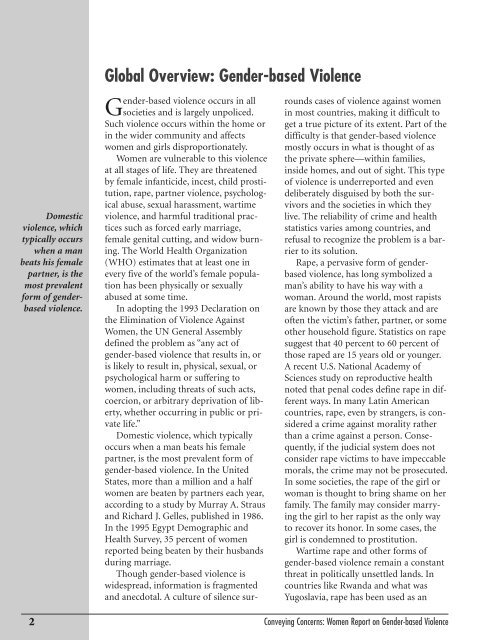Report on ender- ased Report on ender- ased
Report on ender- ased Report on ender- ased
Report on ender- ased Report on ender- ased
You also want an ePaper? Increase the reach of your titles
YUMPU automatically turns print PDFs into web optimized ePapers that Google loves.
Domestic<br />
violence, which<br />
typically occurs<br />
when a man<br />
beats his female<br />
partner, is the<br />
most prevalent<br />
form of g<strong>ender</strong>b<strong>ased</strong><br />
violence.<br />
Global Overview: G<strong>ender</strong>-b<strong>ased</strong> Violence<br />
G<strong>ender</strong>-b<strong>ased</strong> violence occurs in all<br />
societies and is largely unpoliced.<br />
Such violence occurs within the home or<br />
in the wider community and affects<br />
women and girls disproporti<strong>on</strong>ately.<br />
Women are vulnerable to this violence<br />
at all stages of life. They are threatened<br />
by female infanticide, incest, child prostituti<strong>on</strong>,<br />
rape, partner violence, psychological<br />
abuse, sexual harassment, wartime<br />
violence, and harmful traditi<strong>on</strong>al practices<br />
such as forced early marriage,<br />
female genital cutting, and widow burning.<br />
The World Health Organizati<strong>on</strong><br />
(WHO) estimates that at least <strong>on</strong>e in<br />
every five of the world’s female populati<strong>on</strong><br />
has been physically or sexually<br />
abused at some time.<br />
In adopting the 1993 Declarati<strong>on</strong> <strong>on</strong><br />
the Eliminati<strong>on</strong> of Violence Against<br />
Women, the UN General Assembly<br />
defined the problem as “any act of<br />
g<strong>ender</strong>-b<strong>ased</strong> violence that results in, or<br />
is likely to result in, physical, sexual, or<br />
psychological harm or suffering to<br />
women, including threats of such acts,<br />
coerci<strong>on</strong>, or arbitrary deprivati<strong>on</strong> of liberty,<br />
whether occurring in public or private<br />
life.”<br />
Domestic violence, which typically<br />
occurs when a man beats his female<br />
partner, is the most prevalent form of<br />
g<strong>ender</strong>-b<strong>ased</strong> violence. In the United<br />
States, more than a milli<strong>on</strong> and a half<br />
women are beaten by partners each year,<br />
according to a study by Murray A. Straus<br />
and Richard J. Gelles, published in 1986.<br />
In the 1995 Egypt Demographic and<br />
Health Survey, 35 percent of women<br />
reported being beaten by their husbands<br />
during marriage.<br />
Though g<strong>ender</strong>-b<strong>ased</strong> violence is<br />
widespread, informati<strong>on</strong> is fragmented<br />
and anecdotal. A culture of silence sur-<br />
rounds cases of violence against women<br />
in most countries, making it difficult to<br />
get a true picture of its extent. Part of the<br />
difficulty is that g<strong>ender</strong>-b<strong>ased</strong> violence<br />
mostly occurs in what is thought of as<br />
the private sphere—within families,<br />
inside homes, and out of sight. This type<br />
of violence is underreported and even<br />
deliberately disguised by both the survivors<br />
and the societies in which they<br />
live. The reliability of crime and health<br />
statistics varies am<strong>on</strong>g countries, and<br />
refusal to recognize the problem is a barrier<br />
to its soluti<strong>on</strong>.<br />
Rape, a pervasive form of g<strong>ender</strong>b<strong>ased</strong><br />
violence, has l<strong>on</strong>g symbolized a<br />
man’s ability to have his way with a<br />
woman. Around the world, most rapists<br />
are known by those they attack and are<br />
often the victim’s father, partner, or some<br />
other household figure. Statistics <strong>on</strong> rape<br />
suggest that 40 percent to 60 percent of<br />
those raped are 15 years old or younger.<br />
A recent U.S. Nati<strong>on</strong>al Academy of<br />
Sciences study <strong>on</strong> reproductive health<br />
noted that penal codes define rape in different<br />
ways. In many Latin American<br />
countries, rape, even by strangers, is c<strong>on</strong>sidered<br />
a crime against morality rather<br />
than a crime against a pers<strong>on</strong>. C<strong>on</strong>sequently,<br />
if the judicial system does not<br />
c<strong>on</strong>sider rape victims to have impeccable<br />
morals, the crime may not be prosecuted.<br />
In some societies, the rape of the girl or<br />
woman is thought to bring shame <strong>on</strong> her<br />
family. The family may c<strong>on</strong>sider marrying<br />
the girl to her rapist as the <strong>on</strong>ly way<br />
to recover its h<strong>on</strong>or. In some cases, the<br />
girl is c<strong>on</strong>demned to prostituti<strong>on</strong>.<br />
Wartime rape and other forms of<br />
g<strong>ender</strong>-b<strong>ased</strong> violence remain a c<strong>on</strong>stant<br />
threat in politically unsettled lands. In<br />
countries like Rwanda and what was<br />
Yugoslavia, rape has been used as an<br />
2 C<strong>on</strong>veying C<strong>on</strong>cerns: Women <str<strong>on</strong>g>Report</str<strong>on</strong>g> <strong>on</strong> G<strong>ender</strong>-b<strong>ased</strong> Violence

















